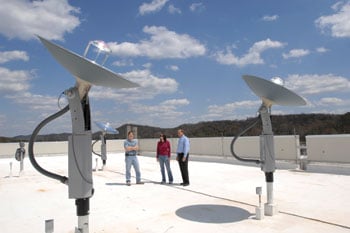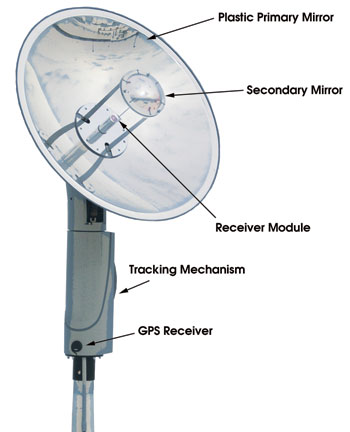Fiber optics brings sunlight inside.
Curt Maxey, Oak Ridge National Laboratory
Hybrid solar lighting systems focus highly concentrated sunlight into a fiber optic bundle to provide sunlight in rooms without windows or conventional skylights. The flexible sunlight bundles are easily routed through small openings and around obstacles to carry the light to where it is needed. The optical fibers terminate in hybrid luminaires where the sunlight is combined with electric light that is automatically adjusted to keep the overall light level constant within the lighted area.
The hybrid solar lighting concept was originally proposed at Oak Ridge National Laboratory in Tennessee in the mid-1990s, but funding hurdles prevented the idea from seeing daylight for more than five years. Hybrid solar lighting was touted as a means for using solar energy directly without any conversion losses and for increasing the visual quality of interior lighting. As such, it promised to be both energy-efficient and aesthetically appealing, but its technical complexity made potential sponsors wary. They had to be convinced that the lighting concept could be accepted into the marketplace and that the systems could be manufactured at an acceptable cost.
An earlier fiber-coupled daylighting system marketed in the early 1990s used expensive quartz optical fibers to distribute the light and served only a niche market that was willing to pay a premium for the novelty. By contrast, the hybrid solar lighting system proposed using inexpensive plastic optical fibers to distribute the light to hybrid (sunlight/electric) luminaires that would be visually and functionally identical to conventional luminaires. In this way, the lighting could be integrated seamlessly into existing design concepts and thus easily embraced by architects and lighting designers as a means for offering daylight as a lighting option.
Finally, after receiving its initial funding from the US Department of Energy, Oak Ridge National Laboratory unveiled in 2002 the first prototype hybrid solar lighting system, which provides lighting for one-half of a second-floor laboratory space. For the first time, visitors could see the contrast in the quality of the fiber-coupled sunlight on one side of the room versus the light from the conventional fluorescent system on the other.
The way it works is that a solar tracker up on the roof follows the sun across the sky (Figure 1). Then, daylight-harvesting sensors maintain a constant level of illumination, even with clouds blocking the sun. With the concept successfully demonstrated, subsequent research efforts were aimed at cost reduction and component reliability.

Figure 1. Up on the roof, the tracker controller system moves with the sun, collecting light into a focused beam that enters the optical fibers. The IR and UV wavelengths are stripped out before the visible light is sent into the building.
The technical complexity of hybrid solar lighting does not easily translate into a cost-effective lighting system. The system must track the sun with an accuracy of one-eighth of an angular degree, regardless of sky conditions, and must concentrate the sunlight (400×) into a focused beam that is narrow enough to enter the numerical aperture of the optical fibers. It also must strip out the infrared and ultraviolet wavelengths because both are potentially damaging to the fiber.
The solar lighting system uses a custom-designed tracker controller that constantly calculates the sun’s position (based on the latitude, longitude, date and time) and sends motion-control signals to the azimuth and zenith motor drives (Figure 2). An inexpensive global positioning system receiver provides a continuously updated clock to ensure reliable tracking. The 1.2-m parabolic primary mirror is a second-surface, aluminized, thermo-formed plastic optic whose performance could be achieved only by advancing the state of the art in plastic mirror manufacturing. The borosilicate secondary mirror is formed using slumped glass to produce a first-surface concave ellipsoid with a mutilayer dielectric coating that reflects only the visible wavelengths, thus stripping the UV and IR from the reflected light.

Figure 2. The sunlight is collected when the tracking mechanism moves toward the sun, and a series of mirrors focus the beam into the receiver.
From the secondary mirror, visible light travels to the fiber optic receiver, where it is homogenized to ensure uniformity before it enters the fiber optic bundle. The receiver is the final component in the thermal management chain, and its proprietary design has evolved through a series of analytical and empirical processes. Even with infrared wavelengths stripped away, introducing highly concentrated sunlight into a bundle of plastic optical fibers has been a daunting thermal management challenge. The path to success has been difficult, with many charred and melted prototypes along the way.
Sunlight Direct Inc. of Oak Ridge, Tenn., has licensed the technology, and approximately 25 units have been installed at various locations in the continental US and Hawaii. Early adopters are attracted to hybrid solar lighting for its quality, which is virtually indistinguishable from natural daylight (Figure 3).

Figure 3. A comparison is shown of the visible solar spectrum and light exiting the hybrid solar system (top) versus the spectrum of a typical 4000 K fluorescent lamp (bottom). The spectral response of the human eye is similar to the solar spectrum and thus radically different from the spectral distribution in the fluorescent lamp. This may explain the subjective preference people have for the daylight spectrum. HSL = hybrid solar lighting.
The next adopters will be attracted to hybrid solar lighting because of energy and cost savings; therefore, many of the current installations are beta test sites where instruments are installed to determine the energy savings from the lighting system. The approximate cost is $20,000 to light a 1000-sq-ft area. One hybrid solar lighting system produces up to 50,000 lumens. The electricity displaced depends on the type of electric light that is being replaced. For example, the electricity savings is less than 500 W when replacing fluorescent lighting but can be more than 3000 W for incandescent.
Tax incentives and local utility rates available within a given region significantly affect the economic benefit. With current design changes, the cost of hybrid solar lighting is expected to fall by more than 50 percent in the next two years. When that happens, going green with fiber-coupled sunlight will be within reach of a lot more consumers.
Meet the author
Curt Maxey is a senior research and development engineer at Oak Ridge National Laboratory in Tennessee; e-mail: [email protected].